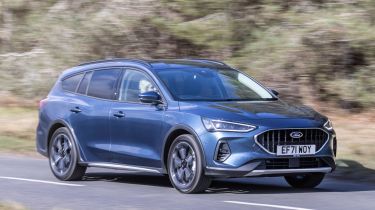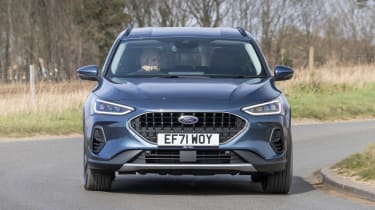Ford Focus Estate review - MPG, CO2 and running costs
Mild hybrid petrol engines help make the Focus Estate a fuel-sipper

The Ford Focus has gone hybrid in a bid to further lower its running costs but there are no plug-in models, just 48-volt mild-hybrid versions of the 1.0-litre Ecoboost engine badged up as mHEV (Mild Hybrid Electric Vehicle). All of the Ecoboost engines also feature cylinder deactivation that can shut down a cylinder to save fuel when the engine isn’t under high loads.
The system replaces a standard alternator with a belt-driven starter/generator motor that means energy otherwise lost as the car slows can be recovered and stored in a battery. As well as helping to power the car’s electrical systems, the motor also gives a torque boost to improve performance or reduce the amount of work the petrol engine is asked to do as required.
The result is some respectable fuel economy numbers across the range, although the mild hybrid version of the 123bhp 1.0-litre Ecoboost is hardly any more efficient than the entry level version of that unit without hybrid assistance. That entry-level engine is rated at 47.1 to 52.3mpg on the WLTP combined cycle with the manual gearbox. The mild-hybrid with the seven-speed Powershift auto gets 47.9 to 52.3mpg and the more powerful 153bhp Ecoboost gets 51.4 to 54.3mpg as a manual or 49.6 to 53.3mpg with the auto. CO2 emissions for these cars are similarly close, all between 116 and 135g/km.
The 1.5-litre Ecoblue diesel is the most efficient, rated between 62.8mpg and 67.3mpg as a manual and between 56.5 and 61.4mpg with the eight-speed auto. Emissions are 110 to 131g/km. Opt for the Focus ST hot hatch and there’s a predictable drop to around 35mpg with emissions of around 183g/km, regardless of gearbox selection.
Insurance groups
Insurance groups for the mainstream Ford Focus Estate models range from around group 13 for the entry-level Trend to Group 16 for a pricier 153bhp Ecoboost ST-Line Vignale. Active models sit at a similar level and the ST performance versions are in group 27.
Depreciation
In spite of all its qualities, the blue oval badge on the nose of the Focus Estate has traditionally made it less sought-after on the second-hand market than, say, a VW Golf. However, depreciation isn't as rapid as you might think, with data suggesting the Focus Estate should hold onto an average of over 55 per cent of its original value after three years and 36,000 miles.
It’s noticeable that the Active variants hold their value less well than the conventional ones, largely sitting in the 46 to 50 per cent retained value range. The ST versions hold on to around 53 per cent while Titanium and ST-Line models with the Vignale pack keep 56 to 58 per cent of their value.
By way of comparison, the VW Golf Estate typically sits a few percentage points higher model for model in the 49 to 60 per cent range.









